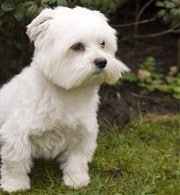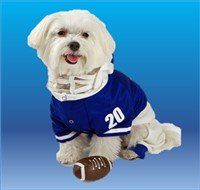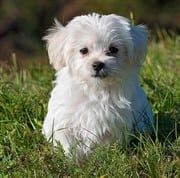Maltese Colors
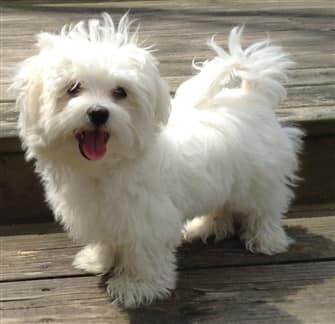
Spunky, photo courtesy of Eldri
Overview
Some may wonder why a page needs to be devoted to the color of the Maltese breed, as it is widely believed that this dog can only be found in pure, solid white.
While this is preferred in show, secondary colors can be found and this traces back to early Maltese dogs.
However, there is a bit more to it than that.
Here we will cover:
- History of colors
- Accepted Maltese colors
- Point colors (eye rims, nose, paws, lips) and Halos
- Eye color
- Belly color
- Nail color
- Coat discoloration
Please note: PetMaltese is reader-supported. Some of the product suggestions on this page are affiliate links. As an Amazon Associate we earn from qualifying purchases. This is at no extra cost to you and helps us continue creating useful content.
The History of Maltese Coloring
The Maltese is an ancient breed, originating
8000 years ago. However, quite a bit of development occurred that lead to the white coat that we see today.
The Maltese was not always found with just a white coat. During a short period from 1902 to 1913, the KC (Kennel Club of the UK) allowed all colors in show. With Maltese other than white, the coat was said to be much coarser and not as silky as their solid white counterparts.
In 1877, a pure white Maltese was shown at the Westminster; at that time he was called the Maltese Lion Dog. Two years later in 1879, a white Maltese with black ears was shown at the Westminster, and was dubbed the Maltese Skye Terrier.
Once the Maltese piqued interest in some breeders in the United States, crossbreeding was done to perfect the breed. It is believed that the eventual goal was a dog that was smaller in size (those first shown at Westminster were 10+ pounds) and to bring the coat to white only.
One record that showed a crossbreeding was to a Pomeranian which produced black puppies. However, the most common pairings were to white toy Poodles; this took place from 1900 to 1910 across the U.S.
It is important to note that during this time there were very few Maltese registered with the AKC. There were just 6 in 1902, and then 50 in the 1950's.
From the 1950's on, the Maltese evolved into a solid white dog, though there can be a touch of color, which lingers from his rich history.
Maltese Accepted Colors
Maltese Accepted Colors
Despite being known as a solid white dog, there other color combinations that can be found.
Per the AKC, there are 3 accepted colors, and one marking.
White is the only standard color (designated with an 'S') and the other two are accepted, but alternate colors (designated with an 'A;)
The colors are:
White (color code S 199)
White and lemon (color code A 211)
White and tan (color code A 217)
The AKC prefers that any lemon or tan falls on the ears only.
The only AKC marking
is black points (code S 019).

Kirby, photo courtesy of the OMelia/Neidermeyer family
This is a standard marking, and refers to the nose, eye rims, lips, and paw pads being solid black. This is preferred in show.
Per the FCI
(Fédération Cynologique Internationale, also known as the World Canine Organization), white is the preferred color, however pale ivory (cream) is permitted. In addition, traces of pale orange are allowed, but with points deducted.
Points - Eye Rims, Nose, Paw Pads, Lips
The vast majority of Maltese dogs have black noses, paw pads, and lips. Such colors as liver, beaver, and chocolate are not found in the bloodline. And in regard to the eye rims, you sometimes see this and sometimes do not. If the eyes rims are dark black and make a full solid line around the eyes, this is known as halos.
If all 4 of these points are seen, the color marking code of S 019 is given, as this is what is needed for full solid black points.
In regard to the nose, if a Maltese is born with a black nose and it later fades, this is not always genetic (more ahead).
Eye Color
Maltese always have dark eyes. This includes black and very dark brown. Blue, green, and hazel are not found in the bloodline.
Maltese Belly Color
Typically, a Maltese's belly will be a light pink. However, as a Maltese matures, the pigmentation on the belly can darken. This is often due to exposure to natural sunlight.
Even if a Maltese's stomach is never facing the sun, a small amount of light is reflected from the ground; this hits the tummy and over the course of months or years can cause a color change.
There may be grey, black, or brown spots. These may increase in the summer and fade in the winter; there are some steps you can take to help fade black spots that develop on a Maltese's skin.
It is a red flag if colored spots on the belly are raised.
Cubbie, photo courtesy of Amy Jo
So, routinely run your hand over your Maltese's belly to ensure that all are flush.
Nail Color
Many owners wonder what color a Maltese dog’s nails should be. The AKC does not have a standard for this, however the FCI does: “nails should be also black or at least of a dark colour”.
And this holds true for many Maltese. The nails will be black or a dark tone in the grey range. For others, though seen less commonly, nails may be cream or a light tan.
Discoloration
It is not common for a Maltese to have a slight color change as he matures; shading may enter the coat or slight spots of lemon or tan may increase with age as Maltese transitions from puppy to adult.
Pure snow white
However, quite a bit of discoloration can be seen with Maltese dogs that have nothing to do with genetics. In many cases, you can take steps to bring your Maltese back to a clear, crisp white.
The coat may become discolored.
This can include tans or browns down around the paws. There may be some yellowing on the chin.
The overall coat may seem to be darker, or even go from a snow white to a cream.
This may be the result of months or years of staining via dirt, debris, and other elements that very gradually affected coat color.
This is not something that happens overnight, so owners often do not even notice. It may be only when you look at photos of a Maltese and compare them to his younger self, that you'll see the coat has discolored.
What to do: 1) Use a quality whitening shampoo that does not dye the coat, but is effective in removing stains from hairs, with ingredients that enhance white like Earthbath Coat Brightener Shampoo .
.
2)
Wipe the entire body daily.
This will be to tidy up in between baths to swipe away bits of sprayed urine, small particles of sand or dirt, and other elements that can cover up the white. Earthbath All Natural Green Tea Leaf Grooming Wipes
 is a great choice for daily wiping.
is a great choice for daily wiping.
3)
Brush every 1, 2 or 3 days depending on coat length.
4)
Never give unfiltered tap water, as minerals and a number of toxins in most tap waters can affect the coat (can lead to health issues).
Discoloration around the eyes.
When you have a dog with a white coat, it can take some effort to keep the coat free of staining.
Most often red, brown, or rust coloring around the eyes is due to tear staining. This refers to moisture from the eyes causing a gradual discoloration, often with red yeast being the culprit.
What to do: Use a quality tear stain remover like Eye Envy Tear Stain Remover Solution , and once the area has cleared up, wipe the eye area 2 or 3 times per day to prevent this from reoccurring.
, and once the area has cleared up, wipe the eye area 2 or 3 times per day to prevent this from reoccurring.
Nose color change:
A Maltese's nose may have a secondary color other than black for one of two reasons.
1)
It may be genetic. Since the parti gene is present within the bloodline of the Maltese breed (able to produce white with tan or lemon coats), the parti factor gene can land on the nose.
Careful breeding can often eliminate this; however, it can be seen.
2)
But, the other element is that a gradual fading of the nose is often due to environmental factors, and may be able to be reversed.
What to do:
There are a number of things:
1)
Do not use plastic bowls.
Even those that are BPA free can cause a contact reaction that causes the nose to fade over the course of months or years. Use stainless-steel instead.
2)
The next one is tricky.
Both a lack of sunlight and overexposure to the outside elements can cause the nose to change color. So,
- Be sure to take your Maltese outside for exercise twice per day, all year round. Staying inside too much, especially in the winter, can cause the nose to fade.
If your Maltese does not tolerate the cold well, and many do not, look into some cute but functional clothing to keep him warm.
- If your Maltese is outside a lot, and lack of sun does not appear to be the issue, but his nose has turned pink or light brown, this may be a case of years of exposure taking their toll.
Cold winds that chap the nose, sun that dries it out, and other elements can cause the skin to become very dry. It will then gradually peel, with the top black layer eventually giving way to a lighter color underneath.
For this, you will want to start using a quality nose balm such as Natural Dog Company's Snout Soother, that works to fix dry nose issues, and protects the sensitive skin of the nose.
Are You a Member Yet?
Sign up to become a free Member. This will allow you to receive newsletters that let you know when new Maltese articles have been written for you. You will also be able to submit photos of your Maltese to be added to this site.
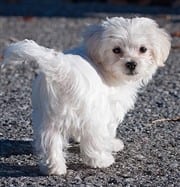
What you decide to feed your Maltese will have a direct impact on both his current health and for years to come. Far too often, inferior brands cause issues such as upset stomach and affect both skin and coat.
See helpful feeding guidelines, schedules, and tips for making sure that your Maltese is properly fueled.
-min-200x189-1920w.jpg)
What you offer for snacks is just as important for meals. And treats play an important role in every type of training that you do, as well as rewarding your Maltese for good behavior. A helpful look at what to avoid and some truly fantastic choices.
Spotlight Article
There are 5 steps to keep a Maltese ultra white, while maintaining excellent skin and coat health.

-min-450x169-1920w.jpg)


-min-281x335-1920w.jpg)
